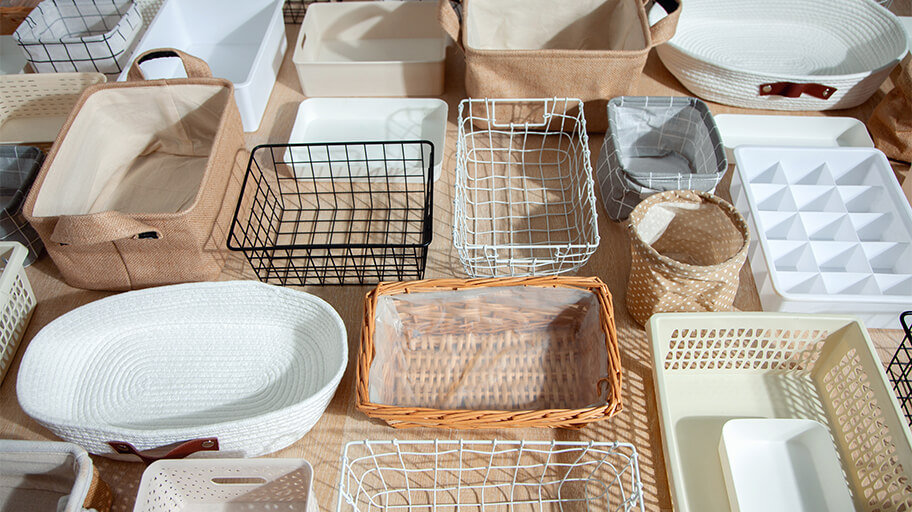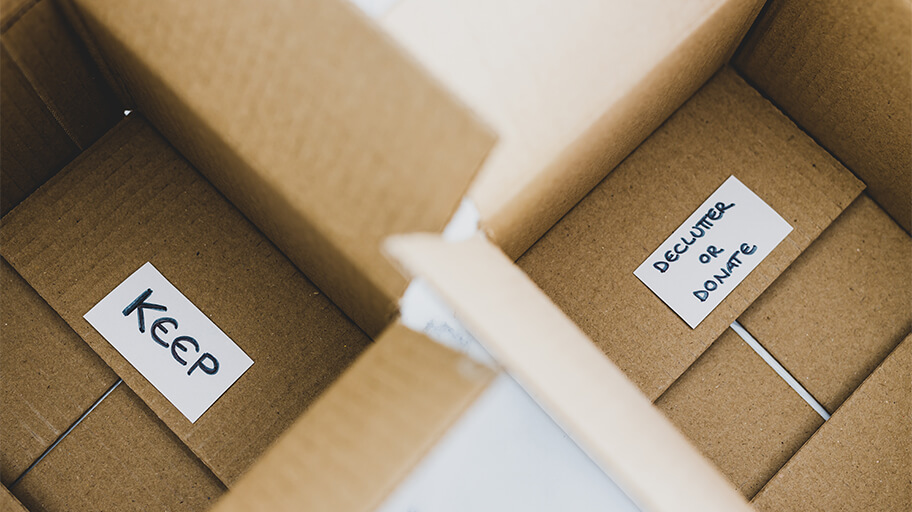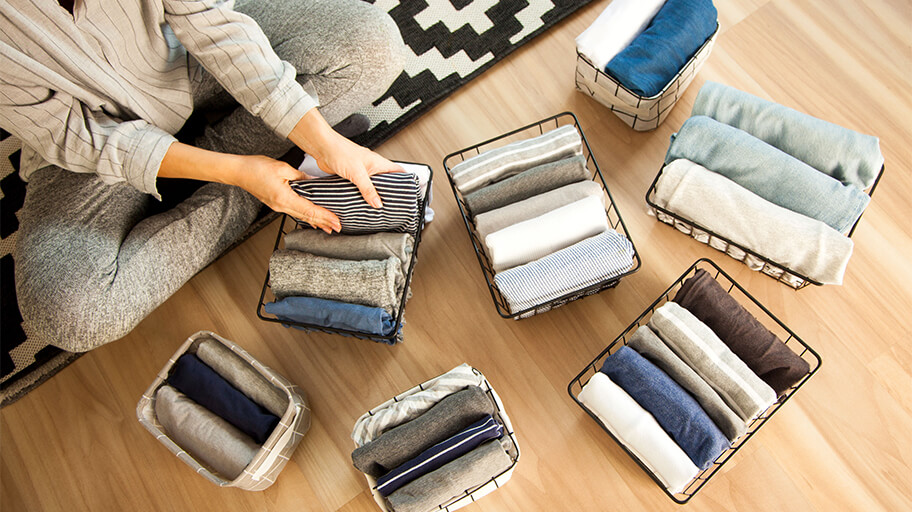Last update: 1 year ago

The piles of stuff around our houses and gather dust are one of the greatest stress triggers for every homeowner. It’s a bad idea to have a lot of clutter around our homes because it distracts us, wastes our time, lowers our self-esteem, and can even increase our cortisol levels and cause chronic restlessness.
For most people, clutter accumulates over time, and we don’t notice until we reach a breaking point. Sometimes this point comes naturally, and we look at our home and realise that there are too many items. And sometimes it’s forced, like a marriage or a divorce, or moving to a new home.
In these cases, we are forced to go over everything we own and evaluate its usefulness. If you want to take charge of your home, get rid of the clutter and learn to live a better life without the influence of pointless items, the Japanese decluttering method of KonMari may be the perfect solution for you.
In this article:
- What is the KonMari Method?
- Lesson #1: Declutter by category, not by rooms
- Lesson #2: Tidy quickly, all at once and for good
- Lesson #3: Keep only what makes you happy
- Lesson #4: “Someday” never comes
- Lesson #5: Fold, don’t hang
- Lesson #6: Your possessions reflect your state of mind
- Lesson #7: There are long-term benefits from practising the KonMari method
- Takeaways
What is the KonMari Method?
KonMari is a global decluttering movement derived from Japanese minimalism, which took over the world in the last few years. The creator of this method is Marie Kondo, a Japanese organizing consultant, who wrote a book about it, named “The Life-Changing Magic of Tidying Up: The Japanese Art of Decluttering and Organizing”. There’s also a Netflix show “Tidying Up With Marie Kondo” based on lessons from the book, starring the one and only Marie Kondo.
Kondo’s services nowadays come with a mile-long waiting list in her own country, and the rest of the world is frantically examining and taking her philosophy to action. The book itself contains the answers to all those nagging housekeeping questions we all have – how to achieve perfectly folded clothes, neat bookshelves, paperless offices, a clutter-free kitchen, and a lot more. But most importantly, it teaches us how to keep only belongings that make us feel good.
So, let’s take a more detailed look at the KonMari decluttering method and see what you can apply in your life as well.
1. Declutter by category, not by rooms

Usually, people organise and declutter their houses room by room or by season (spring cleaning, holiday cleaning, etc.). Even professional organisers tend to execute home organization projects by room or by square footage.
The KonMari method realises that this particular approach may be the reason the success is short-lived and that we have to repeat the same tasks repeatedly. Our items are scattered all over the house, and we often have the same type of items in more than one room. In these conditions, it’s difficult to realise the overall volume, and many homeowners get discouraged before finishing.
This is why the KonMari Method prefers to carry out the decluttering by categories in the following order:
- Clothes (this includes all textiles, linen, towels, etc.)
- Books (including magazines, journals, newspapers, comic books)
- Papers (documents, notebooks, etc.)
- Miscellaneous, named Komono in the book (souvenirs, decorations, accessories, small pieces of furniture)
- Sentimental items (everything that holds dear memories)
2. Tidy quickly, all at once and for good

Many guides would tell you to do things gradually and with time. KonMari is like a harsh detox diet. It encourages swift action, quick thinking and doing everything once and for good.
The whole idea is to do things quickly, efficiently, and not often. According to the book, a decluttering process for the entire house should take around 6 months. By committing to taking care of all the clutter at once, we avoid the mental torment of going over the same things more than once.
We also avoid the endless process of tidying little by little because we all know that this way, things get messy faster than we can clean them.
If you don’t think you can deep-clean your whole house after spending time decluttering, you can also hire a cleaning team to do it instead of you.
3. Keep only what makes you happy

According to Kondo, one of the first steps toward decluttering is to find which items “spark joy” in you. While most organizational theories focus on numerical strategies, e.g. “how many” to throw away, donate or sell, the KonMari focus shifts towards keeping only the things that make you happy and help you become the person you want to be.
Joy can mean something different for everyone, so finding which items spark happiness in you is a real intuitive exercise. Pick up each item separately, don’t just observe it from a distance. Turn it over in your hands, look at it closely, and consider how it makes you feel.
How would you feel if this item was gone forever?
And don’t grab onto the first thing that comes to your mind, which is most often memories of how you got that thing, but think about how it impacts your life today, right now.
4. “Someday” never comes

This is probably the biggest little lie we tell ourselves. Once it comes to throwing something away, we come up with all kinds of reasons (or excuses) why we need to keep that thing instead of tossing it.
But “needing” something is not the same as “loving” it, and it is not a real indication of the value this item has in our lives. If we think about it, all those items that we make excuses for basically sitting around the house for years without us needing or even looking at them, and yet when the time to get rid of them arrives, a feeling of anxiety takes over and prevents us from making the logical decision.
According to KonMari, our belongings are stripped of their dignity when they stay unused in the home and gather dust, and it’s better to let them go.
5. Fold, don’t hang

Once you’ve managed to sort through all your possessions and have discarded all the unnecessary items, it’s time to decide where the remaining things should go.
Most people prefer to hang their clothes on hangers in the closet or fold them in a cubby because it’s considered that this protects them from wrinkles. Kondo claims that most pieces of clothing would be better off (or, as she put it in her book, happier) being folded in a dresser. Most people don’t have the habit of using a dresser for their clothes, but it turns out to be a very practical and space-saving tactic. And if you use Kondo’s special folding technique, you will discover a new meaning of the term “saving space”.
The KonMari vertical folding technique makes everything easy to find and hard to mess up because you don’t have to pick up the piles of clothing to get the thing you want. The KonMari fold is easy to achieve – first, make a long rectangle by folding the two sides to the middle and then fold from the bottom up until you form a little package. Folded this way, the clothing looks like a fabric origami that can be lined in perfect rows.
Then, you can place these packages vertically (not horizontally) in the dresser. Kondo suggests using shoeboxes as drawer dividers to help you arrange the clothes in this way, as some dressers have too big drawers to fit everything perfectly.
6. Your possessions reflect your state of mind

Have you ever wondered why sometimes it’s so difficult to let something go? Kondo claims that we mainly hold onto things because of two emotional reasons – the need to preserve the past and the fear of the future.
And this is a fact – how many of you have started decluttering their old desk drawers to stop and indulge in hours-long journeys down memory lane? Every time we decide to get rid of the clutter in our lives and start clean, we get pulled back by a flood of bittersweet memories. This is not always a bad thing, but it usually means that our possessions have power over us because they show us what we were.
But they are only reminders of the past, they don’t celebrate the present in any way, and KonMari encourages us to cherish the now. By taking control over our possessions, we are no longer ruled by them.
7. Long-term benefits from practising the KonMari method

KonMari is not only a folding or decluttering technique. It’s also a different way of life, which brings order and self-love to our lives. It provides us with an alternative to the traditional organising rules, and it gives us a great feeling of satisfaction in the long term. Here are some of the positives you can expect when you practice KonMari in your everyday routine:
- Finding things is no longer a problem.
You won’t have to dig through an overstuffed closet to find something to wear in the morning and complain that you have nothing to wear, instead you will have a nice collection of clothes you love, and they will be easy to grab and put back. - You can evaluate holes in your wardrobe.
When you realise that you love only one pair of sandals from all ten you own, you start having a better understanding of your own style. This will help you realise what you like and what you don’t, and when you’re shopping for clothes, you will know what to aim for and what you need. - You only collect things you love.
Practicing the KonMari decluttering method makes you pickier in choosing your clothes and possessions, which means that you won’t spend so much money on only somewhat nice things, and you will have the chance to save money for the things you really want. - Your things look better.
It’s a basic psychological trigger, when we love our things, we tend to take better care of them. KonMari is all about respecting our items, and sometimes the biggest sign of respect is to let them go. And if you keep them, you need to treat them properly. - Cleaning is much easier.
Unfortunately, it’s impossible never to clean your home and still have a clean and neat place to live. Even if you practice KonMari, you still have to clean and declutter your home. Still, the cleanups are fewer, farther between and take less time. - You get better at decision-making.
This is probably the best payoff you can get from this exercise. Once you’ve had to evaluate all your belongings and decide if you love them or not, your decision-making abilities will get a lot better. Soon enough, you’ll be able to easily decide on other things too – which book to read, what to make for dinner, which works projects to pursue, and so on.
Takeaways
- It’s easier to declutter by item category, not by rooms.
- Tidy quickly, don’t let yourself get distracted.
- Do you want to be happy? Surround yourself with things that make you happy. And be done with all the rest.
- Don’t postpone. You’re only placing the burden of cleaning up on your future self.
- Re-think your organising method – is there an optimal way of doing things?
- Don’t look at decluttering as a chore but as an investment in your long-term happiness.
Have you tried the KonMari method yet? How did it go for you? Tell us in the comments below!
Do you need a helping hand?
Hire a professional cleaning team!









